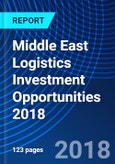Since the oil price crash the GCC countries and Iran have had to adjust to a new set of realities. The region is in a state of political upheaval with Saudi Arabia undergoing a political transformation, Iran emerging from international isolation and an ongoing blockade of Qatar. These developments have profound implications for the region’s economy and logistics sector, with new opportunities emerging from liberalization and previously sound growth strategies now in question.
These factors have necessitated a reassessment of the logistics prospects for the region. This report examines the new set of opportunities by country, sector and logistics market; and identifies the growth models that are no longer viable.
The report provides fundamental background context for assessing the logistics industry at the regional level. This includes:
- PESTLE analysis
- Comparative analysis of the scale and quality of infrastructure by country (container ports, airports, road and rail)
- Comparative economic analysis by country (GDP, GDP growth forecasts, GDP per capita, the price of oil, exports and imports by commodity, export and import forecasts)
- Comparative vertical sector analysis (automotive, chemical, consumer/ retail, defence, e-commerce, healthcare/ pharmaceutical, LNG and oil & gas).
- An introduction to GCC and Iran logistics. This explains the structure and nature of logistics provision in the region, an assessment of how many LSPs there are in various revenue tiers (over €1bn, €500m to €1bn, €100m to €500m, €50m to €100m and less than €50m), estimated revenues of key players and a comparative analysis of logistics performance by country.
The report dives deeper and provides country profiles for Iran and each member of the GCC (Bahrain, Kuwait, Oman, Qatar, Saudi Arabia and the United Arab Emirates).
- Each profile contains an assessment of the size, growth prospects and nature of its core logistics markets (contract logistics, air and sea freight forwarding, domestic and international express). The country’s leading logistics providers are also identified.
- Background context is also provided with each profile including a PESTLE analysis, economic overview, analysis of its core infrastructure (ports, airports, road and railways as well as an infrastructure map) and logistics performance rankings.
- For the core markets of Saudi Arabia, Iran and the UAE, the country profiles go further, featuring in-depth analysis of their core vertical logistics sectors. For the period 2017 to 2021, the publisher has estimated forecast growth windows for the oil & gas logistics and retail logistics sectors. We have also sized the e-commerce logistics market for each of these countries and provided forecasts.
- Each country profile also features an investment environment section. This includes key details on investment rules and regulations as well as major recent investments and planned investments by manufacturers, retailers, LSPs and others.
Also in the report
- The report assesses in detail the key economic and political developments in the region and their impact on industry and logistics. Topics covered include Qatar’s blockade, Iran’s emergence from international isolation, the rise of Saudi Arabia’s young crown prince Muhammad bin Salman and the various diversification strategies away from oil.
- The report identifies airport and container port volumes by country, the highest volume facilities by country and the major development projects by country.








